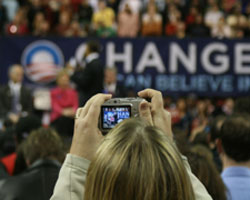The youth vote has been a long-sought prize. This year, research shows the sleeping giant awakening. There needs to be specific legislative goals to create an enduring involvement with citizens passing between the ages of 18 and 30. This agenda must come from youth itself, as well as the political establishment.
This is not the first time the youth vote has been stirred. Urged to Choose or Loose, voting was cool in 1992. At the same time, the economy was slowing, and after 12 years of Reagan/Bush, the 46-year-old Clinton was a fresh face. Clinton made a point to speak to youth. That November, youth turned out in the largest numbers since 1972.
President Clinton remembered this by signing the Rock the Vote–endorsed Motor Voter bill: a law that made voter registration an option when getting a driver’s license. But that was it as far as advancing a specific youth legislative agenda.
Democracy isn’t only about voting. Participation in our public institutions is also part of the experience. Following the ’92 election, without a course or legislative goals, youth stayed away from the 1994 midterms. This was a factor in the Democrats losing control of the U.S. House and Senate. The losses also hit the state houses.
There are many ways to mobilize voters. In 1994, the GOP energized conservatives with the Contract With America. Newt Gingrich was propelled to speaker of the U.S. House with a simple plan. He polled conservative voters, then took that information and presented it as a 10-point agenda. The Republican House kept its pledge, and the proposals were submitted as legislation.
It’s taken for granted that youth don’t care for politics. But things are changing. A new democratic vitality is being cultivated on the Internet. Youth are connecting with peers locally, nationally, and internationally. Even old media, like television, are presenting politics in an entertaining way.
The electronic gizmos help people network, but the rising awareness is also a sign of the times we’re in.
The last half of the ’90s was an era of prosperity and relative peace. There was no big motivation for youth to get involved. Today, there is unease in America. We’re well into a decade of fear and dismay. The slowing economy and war in the Middle East looms over people of all ages.
In such times, Sen. Barack Obama’s message of hope and change is resonating. His appeal to youth is a phenomenon. Like in ’92, this voting block is connecting with the 46-year-old candidate.
If this is indeed the year of the youthquake, let’s hope these voters are not forgotten after the election. The responsibility for preventing this rests with youth themselves. If they do turn out as a significant voting bloc, they need to claim what’s theirs. And that means following up with a legislative agenda.
There are many groups working to get out the youth vote. If successful, they shouldn’t fade from the scenes after November. Let’s build a culture of participation for all ages. The real work will start in January 2009 with the new administration and Congress. There will be much to do at the state level. It’s democracy, and not business as usual, that must endure.





